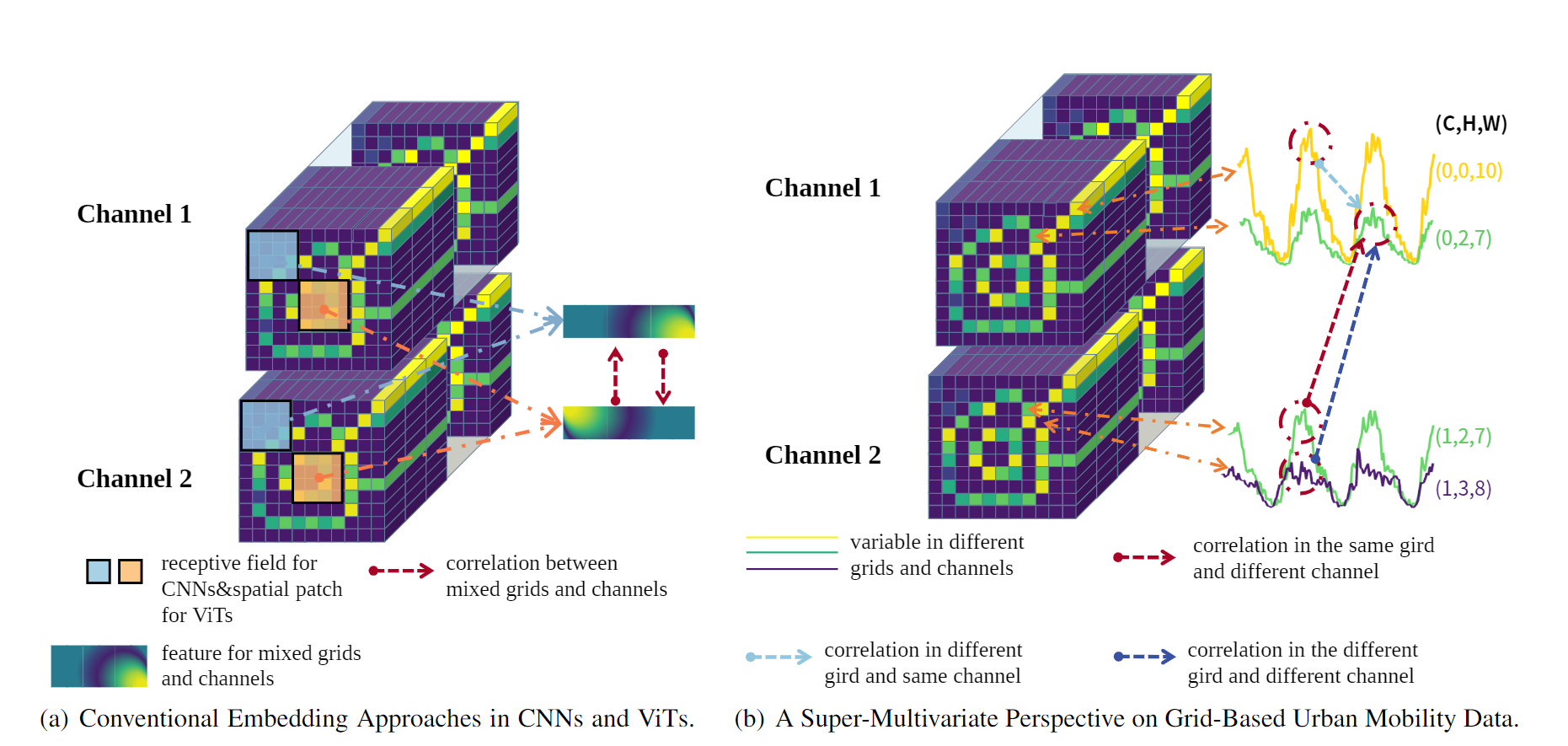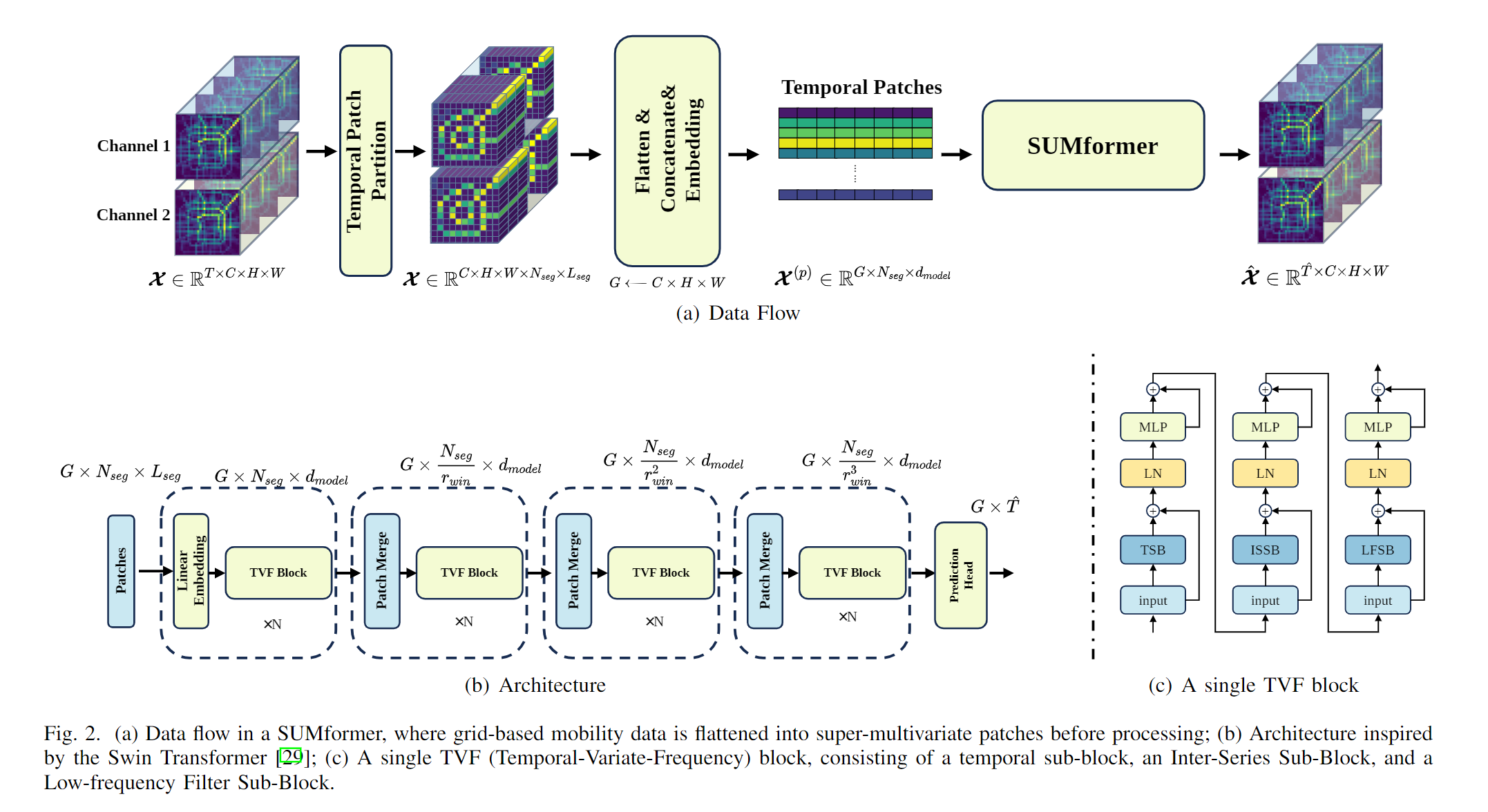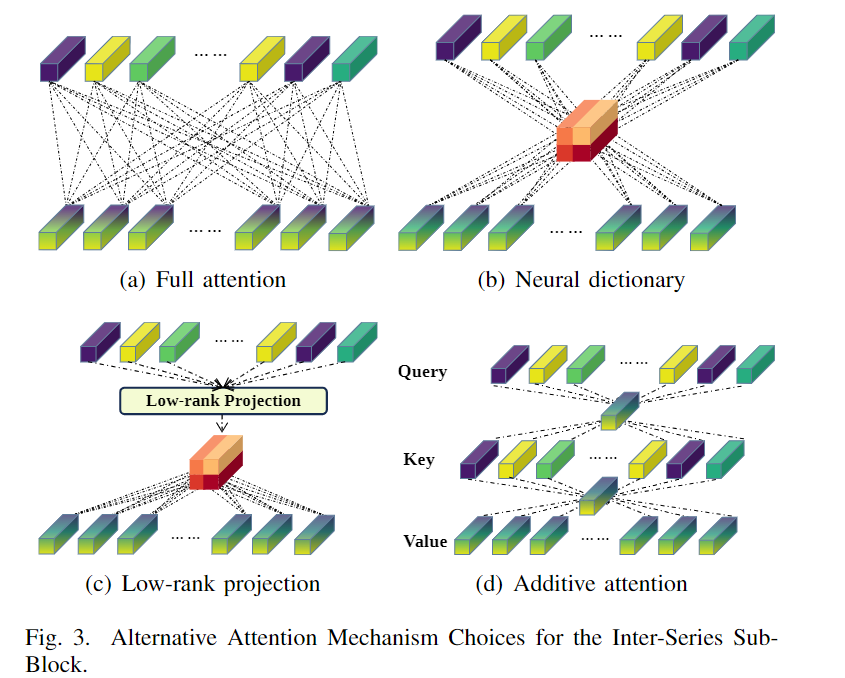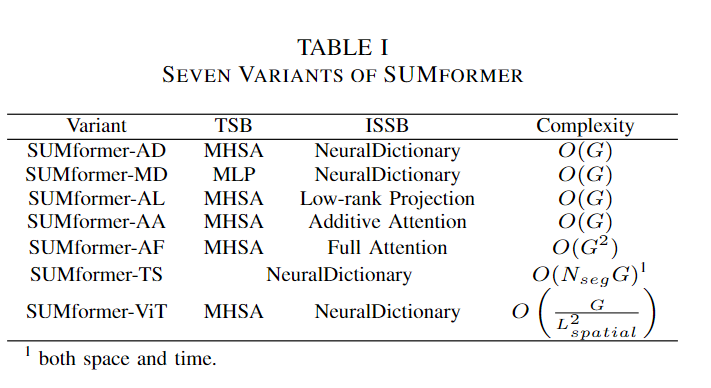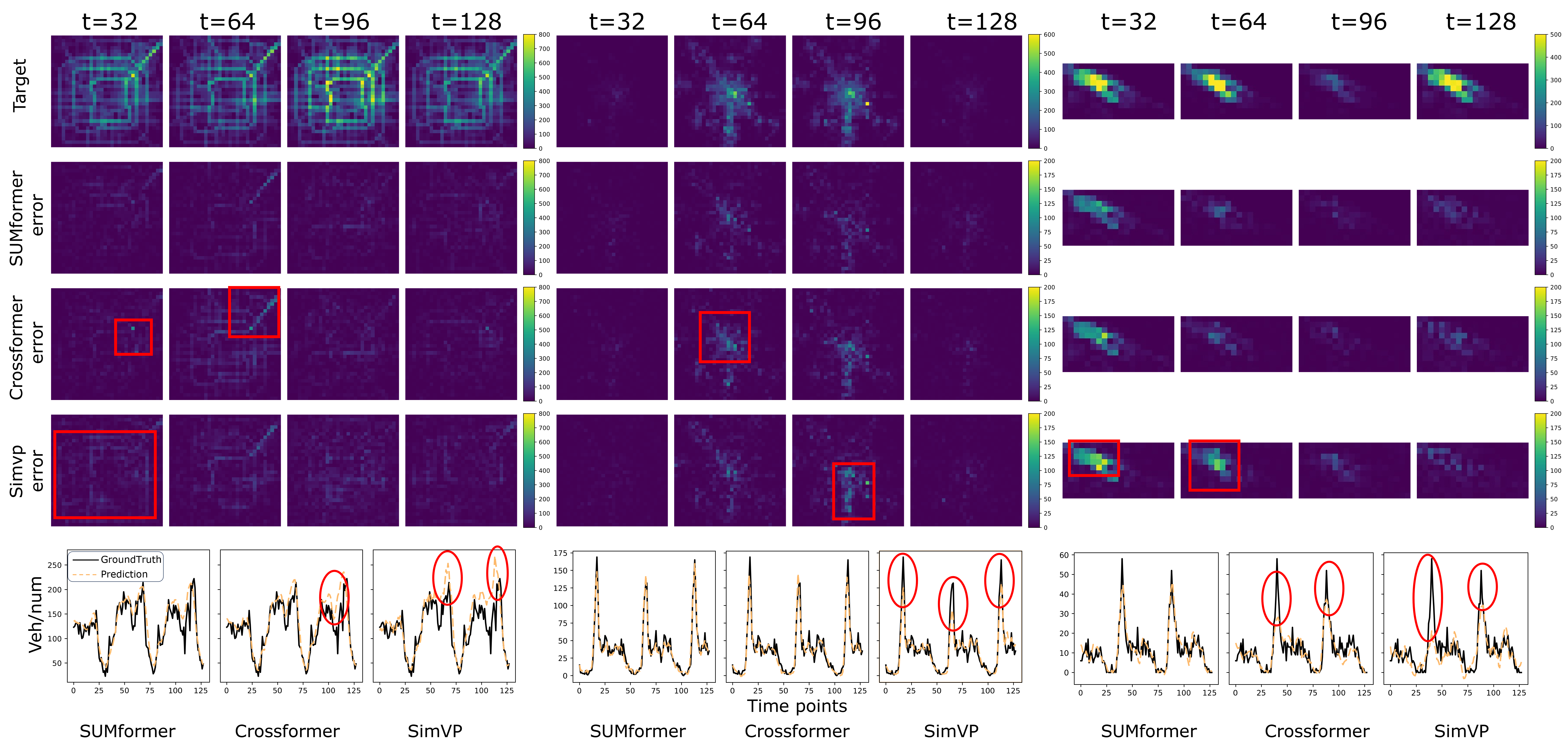Rethinking Urban Mobility Prediction: A Super-Multivariate Time Series Forecasting Approach (SUMformer)
This is the first pytorch implementation for Our Paper: Rethinking Urban Mobility Prediction: A Super-Multivariate Time Series Forecasting Approach.
Long-term urban mobility predictions play a crucial role in the effective management of urban facilities and services. Conventionally, urban mobility data has been structured as spatiotemporal videos, treating longitude and latitude grids as fundamental pixels. Consequently, video prediction methods, relying on Convolutional Neural Networks (CNNs) and Vision Transformers (ViTs), have been instrumental in this domain. In our research, we introduce a fresh perspective on urban mobility prediction. Instead of oversimplifying urban mobility data as traditional video data, we regard it as a complex multivariate time series. This perspective involves treating the time-varying values of each grid in each channel as individual time series, necessitating a thorough examination of temporal dynamics, cross-variable correlations, and frequency-domain insights for precise and reliable predictions. To address this challenge, we present the Super-Multivariate Urban Mobility Transformer (SUMformer), which utilizes a specially designed attention mechanism to calculate temporal and cross-variable correlations and reduce computational costs stemming from a large number of time series. SUMformer also employs low-frequency filters to extract essential information for long-term predictions. Furthermore, SUMformer is structured with a temporal patch merge mechanism, forming a hierarchical framework that enables the capture of multi-scale correlations. Consequently, it excels in urban mobility pattern modeling and long-term prediction, outperforming current state-of-the-art methods across three real-world datasets.
Our contributions to the long-term urban mobility prediction challenge using SUMformer are as follows:
-
We present a novel super-multivariate perspective on grid-based urban mobility data. Through this approach, we are able to utilize general multivariate time series forecasting models to achieve long-term urban mobility predictions.
-
We present the SUMformer: a Transformer model designed to leverage temporal, frequency, and cross-variable correlations for urban mobility forecasting. Notably, it stands out as one of the few Transformer models that explicitly taps into and harnesses cross-variable correlations across every channel and grid for urban mobility prediction.
-
Experiments demonstrate that SUMformer surpasses state-of-the-art methods across three real-world datasets. We emphasize the significance of the super-multivariate perspective, explicit cross-variable correlation modeling, and frequency information for achieving optimal performance.
You could download the dataset from here: Google Drive
Here we list the hyper-parameters we used in the following table.
| Model\Dataset | TaxiBJ | NYC |
|---|---|---|
| SUMformer | lr = 0.0005 layer_scaler = 0.01 spatial_factor = 256 d_model = 128 layer_type = AD/MD/AL/AA/AF/TS layer_depth = [1,1,1,1] | lr = 0.00075 layer_scaler = 1 spatial_factor = 256 d_model = 128 layer_type = AD/MD/AL/AA/AF/TS layer_depth = [2,2,6,2] |
python Sumformer_origin_exp_full.py --device cuda:1 --dataset NYC --pth pth/SUMformer_AD_128NYC.pth
--batch 16 --lr 0.00075
--layer_scaler 1 --layer_type AD
--layer_depth 2 2 6 2
If you want to use your own data to evaluate SUMformer.
-
Make sure your traffic flow data in the format of (T,C,H,W).
-
Modified the date and time interval in datasets/Generate_TAXI_PHV_hotmap.py
-
Make sure the length of the time stamps match the traffic flow data.
python datasets/NYC_time_stamp.py to generate the time stamps for custom data.
We also tested two type of auxiliary loss function in our model but did not work for Super-Multivariate Time Series Forecasting as shown in the two directory above: PeakLoss and SharpLoss. If you are interested in auxiliary loss in time series, please feel free to discuss it with us.
@inproceedings{zhang2023unlocking,
title={Unlocking the Potential of Deep Learning in Peak-Hour Series Forecasting},
author={Zhang, Zhenwei and Wang, Xin and Xie, Jingyuan and Zhang, Heling and Gu, Yuantao},
booktitle={Proceedings of the 32nd ACM International Conference on Information and Knowledge Management},
pages={4415--4419},
year={2023}
}@article{guen2019shape,
title={Shape and time distortion loss for training deep time series forecasting models: Presented at the NeurIPS},
author={Guen, V and Thome, N},
year={2019}
}@inproceedings{gao2022simvp,
title={Simvp: Simpler yet better video prediction},
author={Gao, Zhangyang and Tan, Cheng and Wu, Lirong and Li, Stan Z},
booktitle={Proceedings of the IEEE/CVF Conference on Computer Vision and Pattern Recognition},
pages={3170--3180},
year={2022}
}@inproceedings{tau,
title={Temporal attention unit: Towards efficient spatiotemporal predictive learning},
author={Tan, Cheng and Gao, Zhangyang and Wu, Lirong and Xu, Yongjie and Xia, Jun and Li, Siyuan and Li, Stan Z},
booktitle={Proceedings of the IEEE/CVF Conference on Computer Vision and Pattern Recognition},
pages={18770--18782},
year={2023}
}@inproceedings{crossformer,
title={Crossformer: Transformer utilizing cross-dimension dependency for multivariate time series forecasting},
author={Zhang, Yunhao and Yan, Junchi},
booktitle={The Eleventh International Conference on Learning Representations},
year={2022}
}@article{patchtst,
title={A time series is worth 64 words: Long-term forecasting with transformers},
author={Nie, Yuqi and Nguyen, Nam H and Sinthong, Phanwadee and Kalagnanam, Jayant},
journal={arXiv preprint arXiv:2211.14730},
year={2022}
}@article{FNO,
title={Fourier neural operator for parametric partial differential equations},
author={Li, Zongyi and Kovachki, Nikola and Azizzadenesheli, Kamyar and Liu, Burigede and Bhattacharya, Kaushik and Stuart, Andrew and Anandkumar, Anima},
journal={arXiv preprint arXiv:2010.08895},
year={2020}
}@inproceedings{fedformer,
title={Fedformer: Frequency enhanced decomposed transformer for long-term series forecasting},
author={Zhou, Tian and Ma, Ziqing and Wen, Qingsong and Wang, Xue and Sun, Liang and Jin, Rong},
booktitle={International Conference on Machine Learning},
pages={27268--27286},
year={2022},
organization={PMLR}
}@article{TCN,
title={An empirical evaluation of generic convolutional and recurrent networks for sequence modeling},
author={Bai, Shaojie and Kolter, J Zico and Koltun, Vladlen},
journal={arXiv preprint arXiv:1803.01271},
year={2018}
}@inproceedings{Nlinear,
title={Are transformers effective for time series forecasting?},
author={Zeng, Ailing and Chen, Muxi and Zhang, Lei and Xu, Qiang},
booktitle={Proceedings of the AAAI conference on artificial intelligence},
volume={37},
number={9},
pages={11121--11128},
year={2023}
}@inproceedings{tang2023swinlstm,
title={SwinLSTM: Improving Spatiotemporal Prediction Accuracy using Swin Transformer and LSTM},
author={Tang, Song and Li, Chuang and Zhang, Pu and Tang, RongNian},
booktitle={Proceedings of the IEEE/CVF International Conference on Computer Vision},
pages={13470--13479},
year={2023}
}@article{mlpmixer,
title={Mlp-mixer: An all-mlp architecture for vision},
author={Tolstikhin, Ilya O and Houlsby, Neil and Kolesnikov, Alexander and Beyer, Lucas and Zhai, Xiaohua and Unterthiner, Thomas and Yung, Jessica and Steiner, Andreas and Keysers, Daniel and Uszkoreit, Jakob and others},
journal={Advances in neural information processing systems},
volume={34},
pages={24261--24272},
year={2021}
}@article{gao2022earthformer,
title={Earthformer: Exploring space-time transformers for earth system forecasting},
author={Gao, Zhihan and Shi, Xingjian and Wang, Hao and Zhu, Yi and Wang, Yuyang Bernie and Li, Mu and Yeung, Dit-Yan},
journal={Advances in Neural Information Processing Systems},
volume={35},
pages={25390--25403},
year={2022}
}